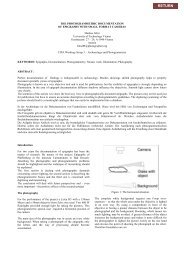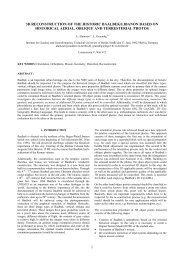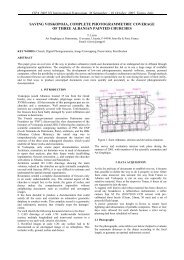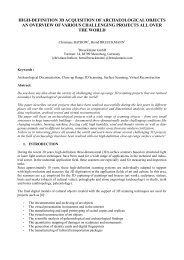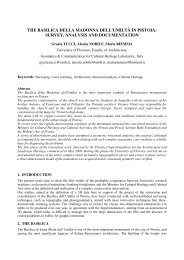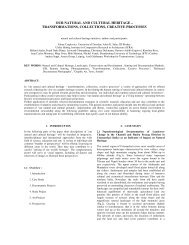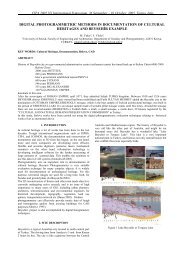CIPA HERITAGE DOCUMENTATION - CIPA - Icomos
CIPA HERITAGE DOCUMENTATION - CIPA - Icomos
CIPA HERITAGE DOCUMENTATION - CIPA - Icomos
Create successful ePaper yourself
Turn your PDF publications into a flip-book with our unique Google optimized e-Paper software.
ABSTRACT<br />
Laser scanning methodology allows to reconstruct the metric<br />
characteristics of objects at different LOD (Level Of Detail) providing<br />
spatially dense points clouds. In particular, the terrestrial<br />
applications carried out in the last years have demonstrated the<br />
potentialities of the methodology useful in many different sectors.<br />
This technique has been used also for the “Cavallo ligneo”<br />
of the “Palazzo della Ragione” (Padua, Italy) survey, providing<br />
useful data for the restoration of the wooden horse. Due to the<br />
morphologic complexity of the object, some lacunas were created<br />
during the points clouds acquisition phase: different procedures<br />
to filling lacunas were stressed out providing a complete<br />
3D model of the wooden statue.<br />
Introduction<br />
Filling lacunas in terrestrial laser<br />
canning data: the “Cavallo ligneo” of the<br />
“Palazzo della Ragione” (Padua, Italy)<br />
M. Fabris, V. Achilli, D. Bragagnolo, A. Menin, G. Salemi<br />
Università degli Studi di Padova, Dipartimento di Architettura, Urbanistica e Rilevamento,<br />
Laboratorio di Rilevamento e Geomatica, via Marzolo, 9, 35131 Padova, Italy, massimo.fabris@unipd.it<br />
Terrestrial laser scanner devices represent one of the most<br />
widely investigated instruments in many fields of architectural<br />
and archaeological surveying applications. In order to allow<br />
photo-realistic navigation and presentation of cultural heritage<br />
objects, 3D models with good geometric accuracy, large<br />
amount of details, different LOD (Level Of Detail) and high<br />
resolution textures are required (Boehler et al., 2001; Boehler<br />
et al., 2003; Schulz, Ingensand, 2004; Staiger, 2005). Since<br />
several years, laser scanning techniques are used for different<br />
purposes also in the framework of cultural heritage (Bitelli,<br />
2002; Lichti, Gordon, 2004). Terrestrial laser data acquisition<br />
allows to collect a very huge amount of measurements with an<br />
accuracy in the range of centimetres or even millimetres,<br />
which produces dense, accurate and detailed models. On the<br />
other hand, for specific geometric conditions of survey or for<br />
the objects interposition during the acquisition, the point<br />
clouds could be not homogeneous and could have sub-areas<br />
with absence of data (holes or lacunas). In these cases, some<br />
interpolation algorithms can be applied to reconstruct the nodata<br />
areas and to define a more uniform support grid.<br />
In this paper, the surveying operations related to data collection<br />
and data analysis of the “Cavallo ligneo” of “Palazzo<br />
della Ragione” in Padua (Italy) are described and discussed in<br />
order to generate a 3D complete model of the wooden horse<br />
for its restoration.<br />
The Wooden Horse Surveying<br />
Documents which have been preserved to the present day tell<br />
us that it was built in 1466 for a roundabout, commissioned<br />
by Conte Annibale Capodilista. It was erroneously attributed to<br />
Donatello, as the inscription on the base shows, but was in<br />
fact the work of an unknown artist. The construction is hollow<br />
inside and built like the hull of a ship, resting on the four sturdy<br />
legs which were made using a technique similar to today’s<br />
segmented beams; i.e. the wooden boards are glued together<br />
on the long side to exploit the tractive force of the wood in full<br />
and minimise the warping typical of solid wood as much as<br />
possible (Fischer, 2004). The wooden horse is characterized<br />
by relevant dimension: 5.75 m height and 6.20 m circumference<br />
of the body (Figure 1).<br />
The object has been planned in order to go inside and to<br />
park in quite comfortably: a trap-door allows the access inside<br />
to the body of the horse, while from the mouth air and<br />
light enter.<br />
The hinge of equilibrium for this complex structure seems<br />
to be the cast iron sphere with a radius of about 27 cm and<br />
weight of about 615 kg. This sphere is the principal point of<br />
anchorage of the horse to the wood basement (along about<br />
6.42 m). In 2004 the structure seemed very degrated and a<br />
complete survey was necessary to plan and to perform restoration<br />
operations for the wood statue.<br />
FIllIng lacunas In terrestrIal laser cannIng data: tHe “cavallo lIgneo” oF tHe “Palazzo della ragIone” (Padua, Italy)<br />
17



